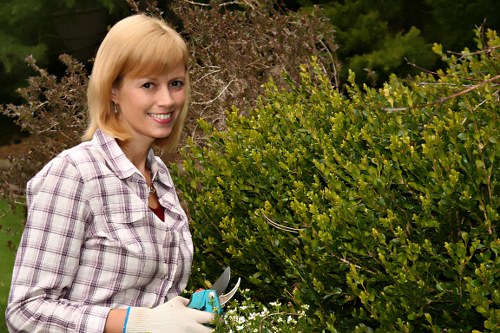Grass Cutting in Garden Fence Replacement
Introduction to Garden Fence Replacement

When it comes to maintaining a beautiful and functional garden, grass cutting and fence replacement are two essential tasks that homeowners often undertake. Properly cutting your grass not only enhances the aesthetic appeal of your garden but also plays a crucial role in the overall health of your lawn. Similarly, replacing old or damaged fences can significantly improve the security, privacy, and visual appeal of your outdoor space.
Integrating grass cutting into your garden fence replacement project can lead to a more cohesive and well-maintained landscape. This article explores the benefits, best practices, and key considerations for combining these two important gardening tasks.
By understanding how grass cutting and fence replacement complement each other, you can create a harmonious outdoor environment that is both beautiful and functional.
Benefits of Combining Grass Cutting with Fence Replacement

Combining grass cutting with fence replacement offers several advantages that can save you time, money, and effort. Here are some of the key benefits:
- Enhanced Aesthetic Appeal: A well-maintained lawn complements a new fence, creating a visually pleasing garden.
- Increased Property Value: A refreshed fence and neatly trimmed grass can boost your property's market value.
- Improved Privacy and Security: Replacing an old fence while maintaining healthy grass ensures both privacy and a secure boundary.
- Cost Efficiency: Managing both tasks simultaneously can reduce labor and equipment costs.
By addressing both grass cutting and fence replacement at the same time, homeowners can achieve a more polished and cohesive outdoor space.
Planning Your Garden Fence Replacement

Effective planning is crucial for a successful garden fence replacement project. Consider the following steps to ensure a smooth process:
- Assess Your Current Fence: Determine the condition of your existing fence and identify any areas that need repair or replacement.
- Choose the Right Materials: Select materials that complement your garden's aesthetic and meet your durability requirements.
- Measure Your Garden Area: Accurate measurements are essential for estimating material needs and costs.
- Consider Local Regulations: Check for any permits or restrictions in your area before starting the replacement.
Proper planning helps in avoiding unexpected challenges and ensures that your fence replacement aligns with your garden maintenance routine.
Integrating Grass Cutting into Fence Replacement

While replacing your garden fence, it's an ideal time to plan your grass cutting strategy. Here's how to effectively integrate these tasks:
- Timing: Schedule the grass cutting around the fence replacement timeline to minimize disruption.
- Equipment Coordination: Use the same tools and machinery for both tasks to optimize efficiency.
- Professional Assistance: Hiring professionals can ensure that both grass cutting and fence replacement are done to high standards.
By synchronizing these activities, you can maintain a neat garden and ensure that the fence replacement process is seamless.
Choosing the Right Grass for Your Garden

Selecting the appropriate type of grass is essential for a healthy and vibrant lawn. Consider the following factors when choosing grass for your garden:
- Climate Compatibility: Choose grass varieties that thrive in your local climate.
- Maintenance Requirements: Some grasses require more frequent cutting and care than others.
- Disease Resistance: Opt for grasses that are resistant to common diseases and pests.
- Sunlight Exposure: Ensure that the grass type you select can prosper in the areas where your fence will be installed.
Proper grass selection enhances the overall look of your garden and complements the new fence.
Steps to Replace Your Garden Fence

Replacing your garden fence involves several important steps. Follow this guide to ensure a successful replacement:
- Remove the Old Fence: Carefully dismantle the existing fence, ensuring minimal disruption to your garden.
- Prepare the Site: Clear the area of any debris and level the ground if necessary.
- Install New Fence Posts: Set the fence posts firmly into the ground, ensuring they are aligned and stable.
- Attach the Fence Panels: Secure the new fence panels to the posts, making sure they are level and evenly spaced.
- Final Touches: Apply any finishes or treatments to protect the fence from the elements.
Each step should be carried out with precision to ensure the longevity and functionality of your new fence.
Maintaining Your Lawn During Fence Replacement

Maintaining your lawn while replacing your garden fence requires careful attention. Here are some tips to keep your grass healthy and lush:
- Regular Mowing: Continue to mow your lawn regularly to prevent overgrowth.
- Watering: Ensure your grass receives adequate water, especially during dry periods.
- Fertilizing: Apply appropriate fertilizers to promote healthy grass growth.
- Weed Control: Remove weeds promptly to prevent them from taking over your lawn.
Consistent lawn care during fence replacement ensures that your garden remains attractive and your new fence stands out beautifully.
Choosing the Right Professionals

Hiring the right professionals for grass cutting and fence replacement can make a significant difference in the outcome of your project. Consider the following when selecting service providers:
- Experience: Look for professionals with a proven track record in both lawn care and fence installation.
- Reputation: Check reviews and ask for references to assess the quality of their work.
- Licensing and Insurance: Ensure that the contractors are properly licensed and insured.
- Cost: Obtain multiple quotes to compare pricing and services offered.
Choosing reputable professionals ensures that your garden fence replacement and grass cutting are executed efficiently and to high standards.
Cost Considerations

Budgeting for garden fence replacement and grass cutting involves several cost factors. Here's what to consider:
- Materials: The type and quality of materials selected for your fence will impact the overall cost.
- Labor: Professional services for fence installation and lawn care can vary in price.
- Additional Features: Add-ons such as decorative elements or advanced fencing systems may increase costs.
- Maintenance: Ongoing maintenance costs for both the fence and lawn should be factored in.
Understanding these cost factors helps in planning your budget effectively and avoiding unexpected expenses.
Environmental Considerations

When undertaking garden fence replacement and grass cutting, it's important to consider the environmental impact:
- Sustainable Materials: Opt for eco-friendly materials that reduce environmental footprint.
- Water Conservation: Implement watering techniques that conserve water and promote sustainable lawn care.
- Waste Management: Dispose of old fence materials responsibly and recycle where possible.
- Biodiversity: Maintain a balance that supports local flora and fauna in your garden.
Environmental considerations contribute to a sustainable and eco-friendly garden, enhancing both its beauty and ecological value.
Common Challenges and Solutions

Replacing a garden fence and maintaining grass can present several challenges. Here are common issues and their solutions:
- Uneven Ground: Ensure proper site preparation by leveling the land before fence installation.
- Pest Infestations: Treat your lawn and fence regularly to prevent and address pest problems.
- Weather Delays: Plan your project timeline considering seasonal weather patterns to minimize delays.
- Budget Overruns: Keep track of expenses and adjust your plans to stay within budget.
By anticipating these challenges, you can implement effective solutions and ensure a smooth project completion.
Final Touches and Enhancements

After successfully replacing your garden fence and cutting the grass, consider adding final touches to enhance your outdoor space:
- Landscaping: Add plants, flowers, or shrubs to complement your new fence and grass.
- Lighting: Install outdoor lighting to highlight your fence and illuminate your garden.
- Decorative Elements: Incorporate garden ornaments, planters, or seating areas for added charm.
- Regular Maintenance: Schedule ongoing lawn care and fence inspections to maintain their condition.
These enhancements can elevate the overall appeal and functionality of your garden, making it a perfect outdoor retreat.
Conclusion

Combining grass cutting with garden fence replacement offers numerous benefits, from improved aesthetics to increased property value. By carefully planning and executing both tasks, homeowners can create a harmonious and well-maintained outdoor space.
Whether you choose to tackle the project yourself or hire professionals, understanding the key aspects of grass cutting and fence replacement ensures a successful outcome that enhances the beauty and functionality of your garden.
Contact us today to learn more about our comprehensive garden maintenance and fence replacement services, and transform your outdoor space into a stunning haven.